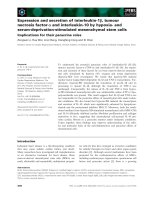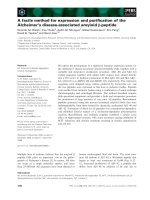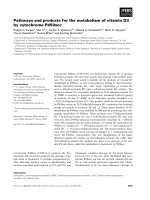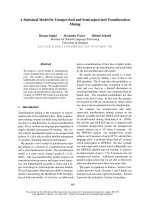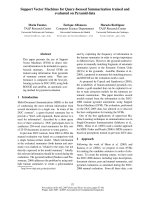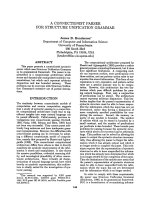Báo cáo khoa học: "SVD and Clustering for Unsupervised POS Tagging" docx
Bạn đang xem bản rút gọn của tài liệu. Xem và tải ngay bản đầy đủ của tài liệu tại đây (199.23 KB, 5 trang )
Proceedings of the ACL 2010 Conference Short Papers, pages 215–219,
Uppsala, Sweden, 11-16 July 2010.
c
2010 Association for Computational Linguistics
SVD and Clustering for Unsupervised POS Tagging
Michael Lamar*
Division of Applied Mathematics
Brown University
Providence, RI, USA
Yariv Maron*
Gonda Brain Research Center
Bar-Ilan University
Ramat-Gan, Israel
Mark Johnson
Department of Computing
Faculty of Science
Macquarie University
Sydney, Australia
Elie Bienenstock
Division of Applied Mathematics
and Department of Neuroscience
Brown University
Providence, RI, USA
Abstract
We revisit the algorithm of Schütze
(1995) for unsupervised part-of-speech
tagging. The algorithm uses reduced-rank
singular value decomposition followed
by clustering to extract latent features
from context distributions. As imple-
mented here, it achieves state-of-the-art
tagging accuracy at considerably less cost
than more recent methods. It can also
produce a range of finer-grained tag-
gings, with potential applications to vari-
ous tasks.
1 Introduction
While supervised approaches are able to solve
the part-of-speech (POS) tagging problem with
over 97% accuracy (Collins 2002; Toutanova et
al. 2003), unsupervised algorithms perform con-
siderably less well. These models attempt to tag
text without resources such as an annotated cor-
pus, a dictionary, etc. The use of singular value
decomposition (SVD) for this problem was in-
troduced in Schütze (1995). Subsequently, a
number of methods for POS tagging without a
dictionary were examined, e.g., by Clark (2000),
Clark (2003), Haghighi and Klein (2006), John-
son (2007), Goldwater and Griffiths (2007), Gao
and Johnson (2008), and Graça et al. (2009).
The latter two, using Hidden Markov Models
(HMMs), exhibit the highest performances to
date for fully unsupervised POS tagging.
The revisited SVD-based approach presented
here, which we call “two-step SVD” or SVD2,
has four important characteristics. First, it
achieves state-of-the-art tagging accuracy.
Second, it requires drastically less computational
effort than the best currently available models.
Third, it demonstrates that state-of-the-art accu-
racy can be realized without disambiguation, i.e.,
without attempting to assign different tags to dif-
ferent tokens of the same type. Finally, with no
significant increase in computational cost, SVD2
can create much finer-grained labelings than typ-
ically produced by other algorithms. When com-
bined with some minimal supervision in post-
processing, this makes the approach useful for
tagging languages that lack the resources re-
quired by fully supervised models.
2 Methods
Following the original work of Schütze (1995),
we begin by constructing a right context matrix,
R, and a left context matrix, L. R
ij
counts the
number of times in the corpus a token of word
type i is immediately followed by a token of
word type j. Similarly, L
ij
counts the number of
times a token of type i is preceded by a token of
type j. We truncate these matrices, including, in
the right and left contexts, only the w
1
most fre-
quent word types. The resulting L and R are of
dimension N
types
×w
1
, where N
types
is the number
of word types (spelling forms) in the corpus, and
w
1
is set to 1000. (The full N
types
× N
types
context
matrices satisfy R = L
T
.)
* These authors contributed equally.
215
Next, both context matrices are factored using
singular value decomposition:
L = U
L
S
L
V
L
T
R = U
R
S
R
V
R
T
.
The diagonal matrices S
L
and S
R
(each of rank
1000) are reduced down to rank r
1
= 100 by re-
placing the 900 smallest singular values in each
matrix with zeros, yielding S
L
*
and S
R
*
. We then
form a pair of latent-descriptor matrices defined
by:
L
*
= U
L
S
L
*
R
*
= U
R
S
R
*
.
Row i in matrix L
*
(resp. R
*
) is the left (resp.
right) latent descriptor for word type i. We next
include a normalization step in which each row
in each of L
*
and R
*
is scaled to unit length,
yielding matrices L
**
and R
**
. Finally, we form a
single descriptor matrix D by concatenating these
matrices into D = [L
**
R
**
]. Row i in matrix D is
the complete latent descriptor for word type i;
this latent descriptor sits on the Cartesian product
of two 100-dimensional unit spheres, hereafter
the 2-sphere.
We next categorize these descriptors into
k
1
= 500 groups, using a k-means clustering algo-
rithm. Centroid initialization is done by placing
the k initial centroids on the descriptors of the k
most frequent words in the corpus. As the de-
scriptors sit on the 2-sphere, we measure the
proximity of a descriptor to a centroid by the dot
product between them; this is equal to the sum of
the cosines of the angles—computed on the left
and right parts—between them. We update each
cluster’s centroid as the weighted average of its
constituents, the weight being the frequency of
the word type; the centroids are then scaled, so
they sit on the 2-sphere. Typically, only a few
dozen iterations are required for full convergence
of the clustering algorithm.
We then apply a second pass of this entire
SVD-and-clustering procedure. In this second
pass, we use the k
1
= 500 clusters from the first
iteration to assemble a new pair of context ma-
trices. Now, R
ij
counts all the cluster-j (j=1… k
1
)
words to the right of word i, and L
ij
counts all the
cluster-j words to the left of word i. The new ma-
trices L and R have dimension N
types
× k
1
.
As in the first pass, we perform reduced-rank
SVD, this time down to rank r
2
= 300, and we
again normalize the descriptors to unit length,
yielding a new pair of latent descriptor matrices
L
**
and R
**
. Finally, we concatenate L
**
and R
**
into a single matrix of descriptors, and cluster
these descriptors into k
2
groups, where k
2
is the
desired number of induced tags. We use the same
weighted k-means algorithm as in the first pass,
again placing the k initial centroids on the de-
scriptors of the k most frequent words in the cor-
pus. The final tag of any token in the corpus is
the cluster number of its type.
3 Data and Evaluation
We ran the SVD2 algorithm described above on
the full Wall Street Journal part of the Penn
Treebank (1,173,766 tokens). Capitalization was
ignored, resulting in N
types
= 43,766, with only a
minor effect on accuracy. Evaluation was done
against the POS-tag annotations of the 45-tag
PTB tagset (hereafter PTB45), and against the
Smith and Eisner (2005) coarse version of the
PTB tagset (hereafter PTB17). We selected the
three evaluation criteria of Gao and Johnson
(2008): M-to-1, 1-to-1, and VI. M-to-1 and 1-to-
1 are the tagging accuracies under the best many-
to-one map and the greedy one-to-one map re-
spectively; VI is a map-free information-
theoretic criterion—see Gao and Johnson (2008)
for details. Although we find M-to-1 to be the
most reliable criterion of the three, we include
the other two criteria for completeness.
In addition to the best M-to-1 map, we also
employ here, for large values of k
2
, a prototype-
based M-to-1 map. To construct this map, we
first find, for each induced tag t, the word type
with which it co-occurs most frequently; we call
this word type the prototype of t. We then query
the annotated data for the most common gold tag
for each prototype, and we map induced tag t to
this gold tag. This prototype-based M-to-1 map
produces accuracy scores no greater—typically
lower—than the best M-to-1 map. We discuss
the value of this approach as a minimally-
supervised post-processing step in Section 5.
4 Results
Low-k performance. Here we present the per-
formance of the SVD2 model when k
2
, the num-
ber of induced tags, is the same or roughly the
same as the number of tags in the gold stan-
dard—hence small. Table 1 compares the per-
formance of SVD2 to other leading models. Fol-
lowing Gao and Johnson (2008), the number of
induced tags is 17 for PTB17 evaluation and 50
for PTB45 evaluation. Thus, with the exception
of Graça et al. (2009) who use 45 induced tags
for PTB45, the number of induced tags is the
same across each column of Table 1.
216
The performance of SVD2 compares favora-
bly to the HMM models. Note that SVD2 is a
deterministic algorithm. The table shows, in pa-
rentheses, the standard deviations reported in
Graça et al. (2009). For the sake of comparison
with Graça et al. (2009), we also note that, with
k
2
= 45, SVD2 scores 0.659 on PTB45. The NVI
scores (Reichart and Rappoport 2009) corres-
ponding to the VI scores for SVD2 are 0.938 for
PTB17 and 0.885 for PTB45. To examine the
sensitivity of the algorithm to its four parameters,
w
1
, r
1
, k
1
, and r
2
, we changed each of these para-
meters separately by a multiplicative factor of
either 0.5 or 2; in neither case did M-to-1 accura-
cy drop by more than 0.014.
This performance was achieved despite the
fact that the SVD2 tagger is mathematically
much simpler than the other models. Our MAT-
LAB implementation of SVD2 takes only a few
minutes to run on a desktop computer, in contrast
to HMM training times of several hours or days
(Gao and Johnson 2008; Johnson 2007).
High-k performance. Not suffering from the
same computational limitations as other models,
SVD2 can easily accommodate high numbers of
induced tags, resulting in fine-grained labelings.
The value of this flexibility is discussed in the
next section. Figure 1 shows, as a function of k
2
,
the tagging accuracy of SVD2 under both the
best and the prototype-based M-to-1 maps (see
Section 3), for both the PTB45 and the PTB17
tagsets. The horizontal one-tag-per-word-type
line in each panel is the theoretical upper limit
for tagging accuracy in non-disambiguating
models (such as SVD2). This limit is the fraction
of all tokens in the corpus whose gold tag is the
most frequent for their type.
5 Discussion
At the heart of the algorithm presented here is
the reduced-rank SVD method of Schütze
(1995), which transforms bigram counts into la-
tent descriptors. In view of the present work,
which achieves state-of-the-art performance
when evaluation is done with the criteria now in
common use, Schütze's original work should
rightly be praised as ahead of its time. The SVD2
model presented here differs from Schütze's
work in many details of implementation—not all
of which are explicitly specified in Schütze
(1995). In what follows, we discuss the features
of SVD2 that are most critical to its performance.
Failure to incorporate any one of them signifi-
Figure 1. Performance of the SVD2 algo-
rithm as a function of the number of induced
tags. Top: PTB45; bottom: PTB17. Each
plot shows the tagging accuracy under the
best and the prototype-based M-to-1 maps, as
well as the upper limit for non-
disambiguating taggers.
M-to-1 1-to-1 VI
Model PTB17 PTB45 PTB17 PTB45 PTB17 PTB45
SVD2
0.730 0.660
0.513 0.467
3.02 3.84
HMM-EM 0.647 0.621 0.431 0.405 3.86 4.48
HMM-VB 0.637 0.605 0.514 0.461 3.44 4.28
HMM-GS 0.674
0.660
0.466
0.499
3.46 4.04
HMM-Sparse(32) 0.702(2.2) 0.654(1.0) 0.495 0.445
VEM (10
-
1
,10
-
1
) 0.682(0.8) 0.546(1.7)
0.528
0.460
Table 1. Tagging accuracy under the best M-to-1 map, the greedy 1-to-1 map, and
VI, for the full PTB45 tagset and the reduced PTB17 tagset. HMM-EM, HMM-VB
and HMM-GS show the best results from Gao and Johnson (2008); HMM-Sparse(32)
and VEM (10
-1
,10
-1
) show the best results from Graça et al. (2009).
217
cantly reduces the performance of the algorithm
(M-to-1 reduced by 0.04 to 0.08).
First, the reduced-rank left-singular vectors
(for the right and left context matrices) are
scaled, i.e., multiplied, by the singular values.
While the resulting descriptors, the rows of L
*
and R
*
, live in a much lower-dimensional space
than the original context vectors, they are
mapped by an angle-preserving map (defined by
the matrices of right-singular vectors V
L
and V
R
)
into vectors in the original space. These mapped
vectors best approximate (in the least-squares
sense) the original context vectors; they have the
same geometric relationships as their equivalent
high-dimensional images, making them good
candidates for the role of word-type descriptors.
A second important feature of the SVD2 algo-
rithm is the unit-length normalization of the la-
tent descriptors, along with the computation of
cluster centroids as the weighted averages of
their constituent vectors. Thanks to this com-
bined device, rare words are treated equally to
frequent words regarding the length of their de-
scriptor vectors, yet contribute less to the place-
ment of centroids.
Finally, while the usual drawback of k-means-
clustering algorithms is the dependency of the
outcome on the initial—usually random—
placement of centroids, our initialization of the k
centroids as the descriptors of the k most fre-
quent word types in the corpus makes the algo-
rithm fully deterministic, and improves its per-
formance substantially: M-to-1 PTB45 by 0.043,
M-to-1 PTB17 by 0.063.
As noted in the Results section, SVD2 is fairly
robust to changes in all four parameters w
1
, r
1
, k
1
,
and r
2
. The values used here were obtained by a
coarse, greedy strategy, where each parameter
was optimized independently. It is worth noting
that dispensing with the second pass altogether,
i.e., clustering directly the latent descriptor vec-
tors obtained in the first pass into the desired
number of induced tags, results in a drop of
Many-to-1 score of only 0.021 for the PTB45
tagset and 0.009 for the PTB17 tagset.
Disambiguation. An obvious limitation of
SVD2 is that it is a non-disambiguating tagger,
assigning the same label to all tokens of a type.
However, this limitation per se is unlikely to be
the main obstacle to the improvement of low-k
performance, since, as is well known, the theo-
retical upper limit for the tagging accuracy of
non-disambiguating models (shown in Fig. 1) is
much higher than the current state-of-the-art for
unsupervised taggers, whether disambiguating or
not.
To further gain insight into how successful
current models are at disambiguating when they
have the power to do so, we examined a collec-
tion of HMM-VB runs (Gao and Johnson 2008)
and asked how the accuracy scores would change
if, after training was completed, the model were
forced to assign the same label to all tokens of
the same type. To answer this question, we de-
termined, for each word type, the modal HMM
state, i.e., the state most frequently assigned by
the HMM to tokens of that type. We then re-
labeled all words with their modal label. The ef-
fect of thus eliminating the disambiguation ca-
pacity of the model was to slightly increase the
tagging accuracy under the best M-to-1 map for
every HMM-VB run (the average increase was
0.026 for PTB17, and 0.015 for PTB45). We
view this as a further indication that, in the cur-
rent state of the art and with regards to tagging
accuracy, limiting oneself to non-disambiguating
models may not adversely affect performance.
To the contrary, this limitation may actually
benefit an approach such as SVD2. Indeed, on
difficult learning tasks, simpler models often be-
have better than more powerful ones (Geman et
al. 1992). HMMs are powerful since they can, in
theory, induce both a system of tags and a system
of contextual patterns that allow them to disam-
biguate word types in terms of these tags. How-
ever, carrying out both of these unsupervised
learning tasks at once is problematic in view of
the very large number of parameters to be esti-
mated compared to the size of the training data
set.
The POS-tagging subtask of disambiguation
may then be construed as a challenge in its own
right: demonstrate effective disambiguation in an
unsupervised model. Specifically, show that tag-
ging accuracy decreases when the model's dis-
ambiguation capacity is removed, by re-labeling
all tokens with their modal label, defined above.
We believe that the SVD2 algorithm presented
here could provide a launching pad for an ap-
proach that would successfully address the dis-
ambiguation challenge. It would do so by allow-
ing a gradual and carefully controlled amount of
ambiguity into an initially non-disambiguating
model. This is left for future work.
Fine-grained labeling. An important feature of
the SVD2 algorithm is its ability to produce a
fine-grained labeling of the data, using a number
of clusters much larger than the number of tags
218
in a syntax-motivated POS-tag system. Such
fine-grained labelings can capture additional lin-
guistic features. To achieve a fine-grained labe-
ling, only the final clustering step in the SVD2
algorithm needs to be changed; the computation-
al cost this entails is negligible. A high-quality
fine-grained labeling, such as achieved by the
SVD2 approach, may be of practical interest as
an input to various types of unsupervised gram-
mar-induction algorithms (Headden et al. 2008).
This application is left for future work.
Prototype-based tagging. One potentially im-
portant practical application of a high-quality
fine-grained labeling is its use for languages
which lack any kind of annotated data. By first
applying the SVD2 algorithm, word types are
grouped together into a few hundred clusters.
Then, a prototype word is automatically ex-
tracted from each cluster. This produces, in a
completely unsupervised way, a list of only a
few hundred words that need to be hand-tagged
by an expert. The results shown in Fig. 1 indicate
that these prototype tags can then be used to tag
the entire corpus with only a minor decrease in
accuracy compared to the best M-to-1 map—the
construction of which requires a fully annotated
corpus. Fig. 1 also indicates that, with only a few
hundred prototypes, the gap left between the ac-
curacy thus achieved and the upper bound for
non-disambiguating models is fairly small.
References
Alexander Clark. 2000. Inducing syntactic categories
by context distribution clustering. In The Fourth
Conference on Natural Language Learning.
Alexander Clark. 2003. Combining distributional and
morphological information for part of speech in-
duction. In 10th Conference of the European Chap-
ter of the Association for Computational Linguis-
tics, pages 59–66.
Michael Collins. 2002. Discriminative training me-
thods for hidden markov models: Theory and expe-
riments with perceptron algorithms. In Proceedings of
the ACL-02 conference on Empirical methods in
natural language processing – Volume 10.
Jianfeng Gao and Mark Johnson. 2008. A comparison
of bayesian estimators for unsupervised Hidden
Markov Model POS taggers. In Proceedings of the
2008 Conference on Empirical Methods in Natural
Language Processing, pages 344–352.
Stuart Geman, Elie Bienenstock and René Doursat.
1992. Neural Networks and the Bias/Variance Di-
lemma. Neural Computation, 4 (1), pages 1–58.
Sharon Goldwater and Tom Griffiths. 2007. A fully
Bayesian approach to unsupervised part-of-speech
tagging. In Proceedings of the 45th Annual Meet-
ing of the Association of Computational Linguis-
tics, pages 744–751.
João V. Graça, Kuzman Ganchev, Ben Taskar, and
Fernando Pereira. 2009. Posterior vs. Parameter
Sparsity in Latent Variable Models. In Neural In-
formation Processing Systems Conference (NIPS).
Aria Haghighi and Dan Klein. 2006. Prototype-driven
learning for sequence models. In Proceedings of
the Human Language Technology Conference of
the NAACL, Main Conference, pages 320–327,
New York City, USA, June. Association for Com-
putational Linguistics.
William P. Headden, David McClosky, and Eugene
Charniak. 2008. Evaluating unsupervised part-of-
speech tagging for grammar induction. In Proceed-
ings of the International Conference on Computa-
tional Linguistics (COLING ’08).
Mark Johnson. 2007. Why doesn’t EM find good
HMM POS-taggers? In Proceedings of the 2007
Joint Conference on Empirical Methods in Natural
Language Processing and Computational Natural
Language Learning (EMNLP-CoNLL), pages 296–
305.
Marina Meilă. 2003. Comparing clusterings by the
variation of information. In Bernhard Schölkopf
and Manfred K. Warmuth, editors, COLT 2003:
The Sixteenth Annual Conference on Learning
Theory, volume 2777 of Lecture Notes in Comput-
er Science, pages 173–187. Springer.
Roi Reichart and Ari Rappoport. 2009. The NVI
Clustering Evaluation Measure. In Proceedings of
the Thirteenth Conference on Computational Natu-
ral Language Learning (CoNLL), pages 165–173.
Hinrich Schütze. 1995. Distributional part-of-speech
tagging. In Proceedings of the seventh conference
on European chapter of the Association for Com-
putational Linguistics, pages 141–148.
Noah A. Smith and Jason Eisner. 2005. Contrastive
estimation: Training log-linear models on unla-
beled data. In Proceedings of the 43rd Annual
Meeting of the Association for Computational Lin-
guistics (ACL’05), pages 354–362.
Kristina Toutanova, Dan Klein, Christopher D. Man-
ning and Yoram Singer. 2003. Feature-rich part-of-
speech tagging with a cyclic dependency network.
In Proceedings of HLT-NAACL 2003, pages 252-
259.
219
